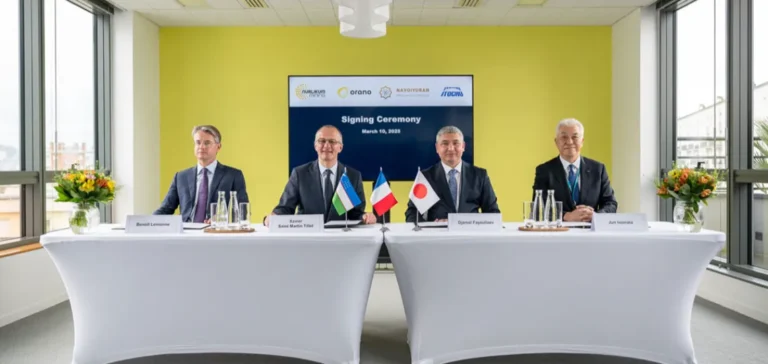The Nurlikum Mining joint venture, established by the Uzbek state-owned company Navoiyuran, French group Orano and Japanese firm ITOCHU Corporation, has entered a new strategic phase with the launch of uranium extraction at the South Djengeldi deposit. Located in the Tomdi district of the Navoiy region, this mining project marks a step forward in the trilateral cooperation developed over recent years.
On March 10, 2025, the three partners signed an agreement in Paris confirming ITOCHU Corporation’s entry into the joint venture’s shareholding structure. Under the new structure, Navoiyuran and Orano each hold 45% of the shares, with ITOCHU Corporation holding the remaining 10%. This adjustment transforms the previous exploration partnership into a full industrial collaboration, with responsibilities now shared across operational activities.
Local integration and cost reduction
The project will be incorporated into Navoiyuran’s existing industrial base, leveraging the available infrastructure in the region. This integration aims to optimise mining operations by reducing production costs while increasing efficiency. The state-owned company will oversee project operations, drawing on its local presence and logistical capacity to manage the project rollout.
South Djengeldi is expected to yield an average of 500 tonnes of uranium annually over the next ten years. Peak production may reach 700 tonnes per year, according to early technical estimates, reinforcing Uzbekistan’s growing role in the global uranium market.
Long-term strategic programme
The development forms part of the strategic cooperation programme signed in 2022 between Orano and the Government of the Republic of Uzbekistan. The partnership aims to expand the country’s exploration and production capacity through joint projects. In this context, geological campaigns are planned to identify new exploitable resources.
The partners aim to significantly increase available reserves, with the stated minimum goal of doubling current mineral resources in the coming years. This initiative responds to rising global demand for uranium, driven by the expansion of civilian nuclear programmes in several parts of the world.






















